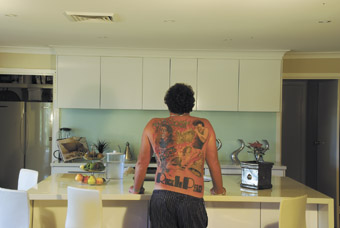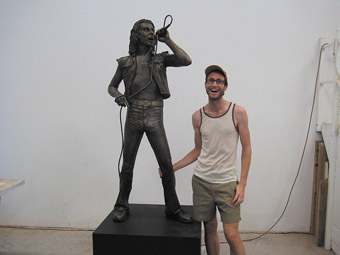talking bon scott
fremantle arts centre makes art a public conversation

Glen in the kitchen, digital print, 2007, Bon Scott Photo Project
photo Rebecca Dagnall
Glen in the kitchen, digital print, 2007, Bon Scott Photo Project
THE IDEA OF STAGING A BON SCOTT EXHIBITION, SAYS CURATOR JASMIN STEPHENS, CAME FROM THE FREMANTLE ARTS CENTRE’S DIRECTOR JIM CATHCART, A PASSIONATE BON SCOTT FAN. FOR STEPHENS, THE FAC’S CURATOR/EXHIBITIONS MANAGER, THE STATUE OF THE LEAD SINGER AND CO-LYRICIST OF AC/DC (SCULPTED BY FREMANTLE ARTIST GREG JAMES WITH FUNDS RAISED BY THE WA BON SCOTT FAN CLUB AND UNVEILED FEBRUARY 24 THIS YEAR) WAS A FINE TRIBUTE. BUT THERE WAS INEVITABLY SOMETHING STATIC ABOUT THE RESULT, ESPECIALLY GIVEN THE SINGER’S LARRIKIN AND OUTSIDER STATUS. THE FAC THOUGHT THAT THE CELEBRATION OF A LIFE COULD BECOME, SAYS STEPHENS, “AN OPPORTUNITY TO STRIKE UP A CONVERSATION ABOUT PUBLIC ART AND HERITAGE.”
One strand of that conversation has been realised in artist Lucas Ihlein’s popular Bon Scott Blog. Ihlein writes in his introduction, “Lucas was not a fan of AC/DC. You can read about his process of immersion! He is meeting fans, visiting cemeteries, chasing up Bon’s old friends and lovers, attending concerts, and listening to a lot of heavy rock.” It’s a fascinating read. A good starting point is Ihlein’s account of his visit to the Fremantle Cemetery where there’s a humble memorial plaque for Scott, a missing heritage plaque and a steady flow of intriguing pilgrims, including Ben Scott, the alleged love child of the singer. The responses to this entry reveal the wide range of people The Bon Scott Project is engaging.

Lucas Ilhein and Statue of Bon Scott
photo Simmo
Lucas Ilhein and Statue of Bon Scott
Jasmin Stephens sees Ihlein’s blog “as a public art work”, playing a much more significant role than the internet’s usually illustrative and educational functions in galleries: “The web is often an afterthought, developed after the conceptualisation of the show.” However, “Fremantle Arts Centre was prepared to make a substantial investment in Lucas for six months of working on the blog and travelling.” A “blogging-as-art project”, as Ihlein describes it, it aims to develop a conversation around the exhibition and be one of a number of dialogues (a fashion show, a tribute band performance, a Bon Scott letters exhibit) with the FAC audience beyond the central exhibition of art works—an opportunity too for substantial audience building.
Another public front is the Ihlein-curated Bon Scott Electronic Sign Project, an LCD screen visible near the old bridge into Fremantle made available by the Fremantle Chamber of Commerce during the exhibition. Ihlein will post messages from fans from all around the world during the course of the exhibition.
How were the participating artists selected for the exhibition at FAC? They had to be interested in the Bon Scott phenomenon but, says Stephens, didn’t have to be fans: “Scott’s fans have shared codes and vocabularies. We wanted artists who are not necessarily fans to break open some of these with a range of responses.” She comments that there are more Scott fans today than when the singer was alive, and they’re often quite young. Themes that have emerged are remembrance, masculinity and rebellion, and a nostalgia for the 70s (as opposed to the 60s lauded by one generation of parents and, says Stephens, her university lecturers). Curious pieces of information emerge from such investigations: there are more AC/DC fans in the northern hemisphere than in the south; many people don’t know that the band is Australian—some think it’s German!
Victorian artist Richard Lewer, who draws, paints and makes video installations, was raised a strict Catholic in a family that saw Scott as satanic. Sydney’s Adam Cullen, who enjoys his own bad boy status, has long been intrigued with how working class male culture expresses itself. Perhaps, says Stephens, “we need a class analysis to understand Bon.” Alex Gawronski, also from Sydney, continues his research into the globalisation of the art world, addressing how being a bad boy can be a career strategy. Western Australian artist Rebecca Dagnall looks at how fans celebrate Scott, photographing them in their homes and documenting the shrines they maintain. Melbourne’s Ian Haig, 11 years old in 1975, recreates the world of the Ringwood Shopping Centre where he saw the band perform. Local artist Bevan Honey is creating an apparition of Bon Scott, sometimes visible, sometimes not, beneath the bridge on the way into Fremantle. Western Australian artist Ryan Nazzari’s suite of paintings evoke the singer’s dark side and are, says Stephens, “very painful to look at, very dark, very black, like imploding stars. What brings a man to the point where he dies alone?”
The sex and death connection is inevitable when dealing with Bon Scott who, although not conventionally handsome, was amazingly promiscuous. Stephens says that the singer was “a prolific letter writer, keeping in touch with the many women he’d met on his travels, often trying out in the letters the lyrics composed and rehearsed on his lonely touring schedules.” Katie Dyer has curated the first ever exhibition of the Bon Scott letters.
As well as the exhibition of artworks in response to the Scott phenomenon and the showing of the letters, there’s a Bon & Fashion night (coincidentally artist Scott Redford’s work will focus on the tightness of the singer’s jeans) and a Perth AC/DC tribute band titled FAC/DC. Stephens reports that once word got out about the exhibition, FAC was swamped with offers from AC/DC cover bands from around the world to come to Perth at their own cost. FAC thought this through and felt happier about putting together a band from strong local talent. It includes two female members, one of them the lead singer, a wry comment on changing times but, asserts Stephens, no less a powerful recreation of the band.
Stephens herself feels that “she’s come to know Bon Scott quite well. Entering his world I’ve met so many men who are his fans and supporters of this project.” That includes Fremantle Mayor, Peter Tagliaferri, but there’s also no shortage of female followers, like Alannah McTiernan, WA Minister for Planning and Infrastructure who turned out to be a huge fan.
The Bon Scott Project is innovative on a number of fronts, providing art with a more public face than is usual, not just because of its subject, a major popular figure, but because it connects with its potential audience through the internet, autobiographically through Scott’s correspondence, and via fashion, live music and intriguing responses from a largely younger generation of Australia’s visual artists. It’s a big conversation, doubtless with a lot of singing along. RT
The Bon Scott Project, curator Jasmin Stephens, artists Stuart Bailey, Guy Benfield, Adam Cullen, Rebecca Dagnall, Cecilia Fogelberg, Alex Gawronski, Ian Haig, Bevan Honey, Matthew Hunt, Lucas Ihlein, Richard Lewer, Michael Moran, Ryan Nazzari, Vanila Netto, Nat Paton, Scott Redford, Eli Smith, Martin Smith, Tanja Visosevic; Fremantle Arts Centre, May 17-June 30; www.fac.org.au/bon_scott_project.php; www.bonscottblog.com
RealTime issue #84 April-May 2008 pg. 47






